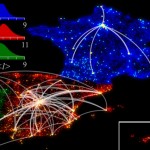 As social and mobile data has mushroomed, there have been increasing attempts to try and use the data we generate to understand how we behave. I wrote recently, for instance, about how Twitter data can paint an increasingly accurate picture of our behaviors.
As social and mobile data has mushroomed, there have been increasing attempts to try and use the data we generate to understand how we behave. I wrote recently, for instance, about how Twitter data can paint an increasingly accurate picture of our behaviors.
This data is increasingly being used to understand how we behave in the real world. For instance, researchers recently looked at our social media content to try and accurately map our night time antics. They were able to create accurate maps of our nocturnal travels and provide urban planners with another layer of granularity when devising policy.
A recent MIT study has attempted to dive even further into things and attempt to understand just what it is that underpins our social networks, and the implications of this.
The study finds that, contrary to previous thinking, our urban networks are often determined by social ties rather than geography.
“I was interested to investigate the relationship of social networks and human distance with the built environment and urban transportation,” the authors say. “We found that geography plays only a minor role when forming social networking communities within cities. Unlike the country, cities have more dispersed communities.”
The authors believe that a better understanding of how information flows through a city is crucial for implementing sustainable urban policies.
The study saw phone data from some 25 million people across three countries extracted over a six month period. This data was used to determine network communities within a city.
Urban networks
The study showed how cities fundamentally change the structure of social networks. Through monitoring over 7 billion phone interactions they were able to explore the role both social and geographic distances play in the formation of our social networks.
It emerged that social distance played a much bigger role than geographic proximity. In other words, our social networks are formed of people with comparable interests and careers rather than those who reside or work nearby.
Urban growth
The authors contend that this is likely to be because of the difficulties inherent in defining and measuring social distance. Despite this however, it’s crucial to understand both where communities are and how they’re expanding.
They believe that this level of understanding is crucial if we’re to understand how information, and indeed other ‘infectious’ things, spread through cities.
It’s also crucial to the development of policies surrounding issues such as segregation and political divisions. The researchers believe that their study proves how effective we have been at building communities that connect people to the resources they need, even whilst ignoring the bulk of the social network.
“This is a remarkably difficult challenge that mankind has solved in a self-organized way,” they say. The research has the potential to inspire the creation of a new generation of communications and transportation infrastructures that are decentralized and more focused on society’s use of them.
In future studies, the team hope to delve further into this and explore the impact things like socioeconomic status, age and gender of people have on their network formation.
Cool post.